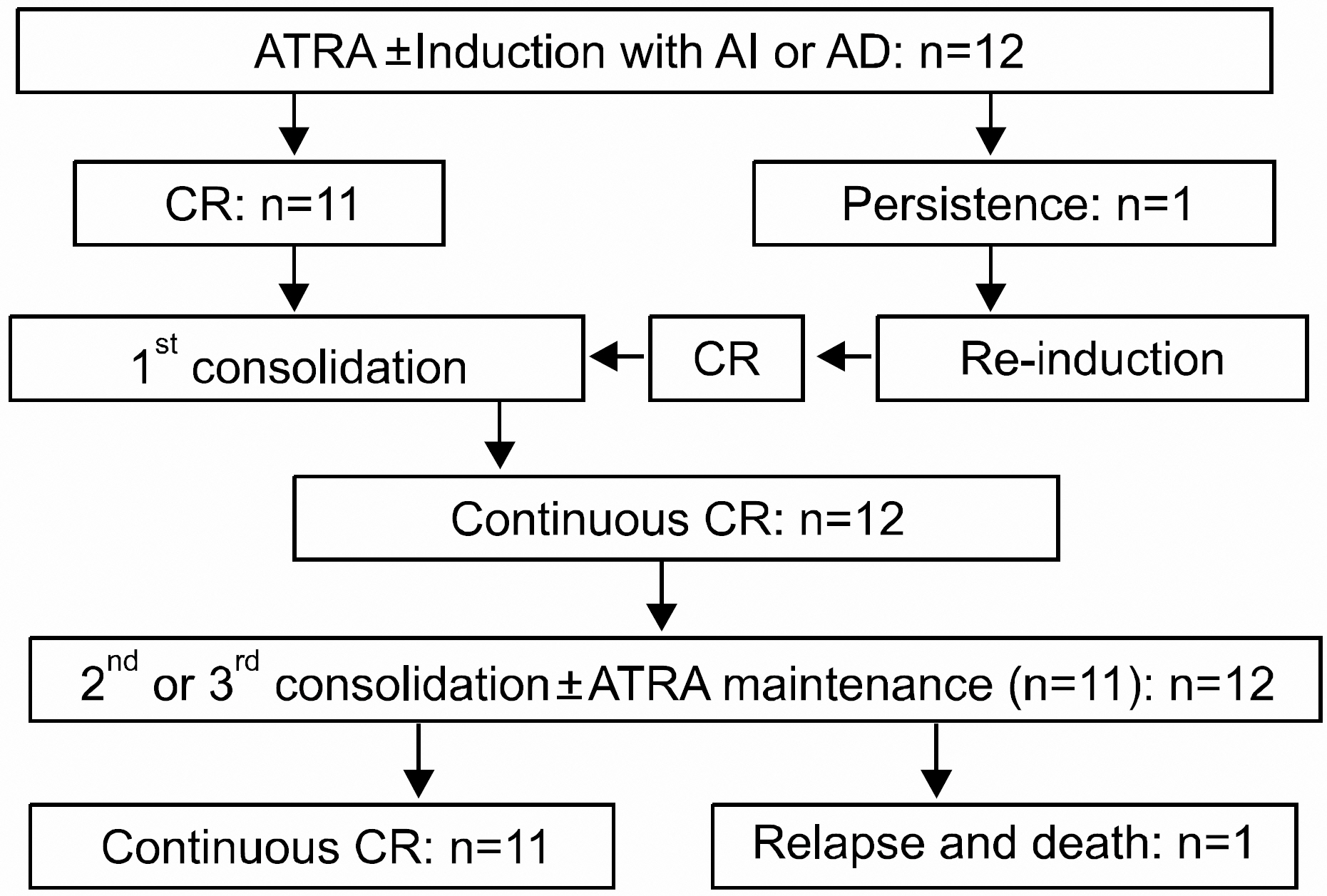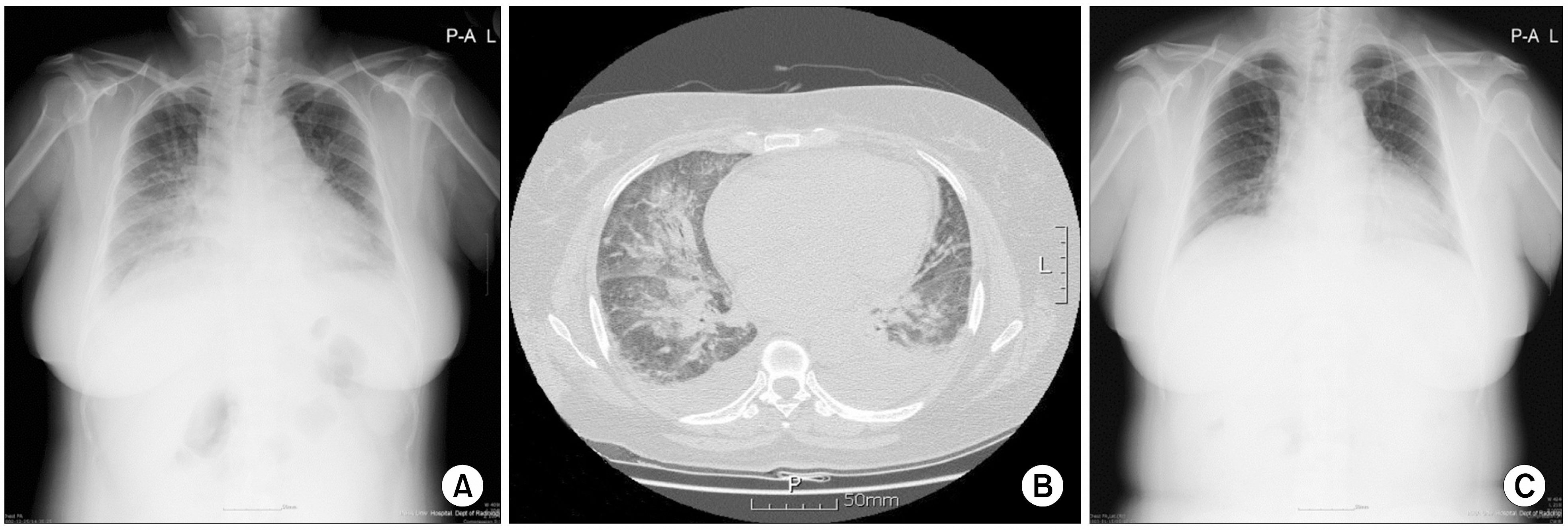Korean J Hematol.
2006 Dec;41(4):289-296. 10.5045/kjh.2006.41.4.289.
Ten-year Experience on Acute Promyelocytic Leukemia at Inha University Hospital
- Affiliations
-
- 1Department of Internal Medicine, Inha University Hospital and College of Medicine, Incheon, Korea. cskimmd@inha.ac.kr
- 2Department of Laboratory Medicine, Inha University Hospital and College of Medicine, Incheon, Korea.
- KMID: 2305216
- DOI: http://doi.org/10.5045/kjh.2006.41.4.289
Abstract
-
BACKGROUND: Acute promyelocytic leukemia (APL) is a distinct subtype of acute myeloid leukemia in its morphology as well as molecular or genetic profiles, conferring a good prognosis owing to the active roles of all-trans-retinoic acid (ATRA) and anthracyclines.
METHODS
Patients diagnosed as APL from March 1997 to April 2006 were analyzed on their clinical features, laboratory profiles, methods of treatment including remission induction, consolidation and maintenance, treatment outcomes, and treatment-related morbidity.
RESULTS
Chemotherapy naive were all the 12 patients in our study consisting of 3 males and 9 females. All patients showed typical morphologic feature of APL with cytogenetic abnormality, t(15;17), and PML/RAR alpha fusion gene was confirmed in 10 patients by FISH or PCR. The combination of cytarabine with daunorubicin (n=2) or idarubicin (n=9) was used as an induction regimen with concurrent ATRA administration. For consolidation therapy, cytarabine with anthracycline (n=4) or idarubicin monotherapy (n=8) was used with ATRA. Cytogenetic and molecular remissions were documented after induction chemotherapy (n=11) or first consolidation therapy (n=1). Maintenance therapy with ATRA was done in 11 patients. CR was obtained in 12 patients, with median remission duration of 30.5+ months (range 2 to 86+) at a median follow up duration of 33.5+ months (range 4 to 89+). One patient relapsed after completion of maintenance therapy and died of infection during reinduction chemotherapy.
CONCLUSION
Herein is the report of ten years' experience of our hospital in the treatment of APL with favorable results as seen by high CR rate and fewer complications.
Keyword
MeSH Terms
-
Anthracyclines
Chromosome Aberrations
Cytarabine
Cytogenetics
Daunorubicin
Drug Therapy
Female
Follow-Up Studies
Humans
Idarubicin
Induction Chemotherapy
Leukemia, Myeloid, Acute
Leukemia, Promyelocytic, Acute*
Male
Polymerase Chain Reaction
Prognosis
Remission Induction
Tretinoin
Anthracyclines
Cytarabine
Daunorubicin
Idarubicin
Tretinoin
Figure
Cited by 1 articles
-
Current routine practice and clinico-pathological characteristics associated with acute promyelocytic leukemia in Korea
Sunhyun Ahn, Joon Seong Park, Seong Hyun Jeong, Hyun Woo Lee, Jun Eun Park, Mi Hyang Kim, Yang Soo Kim, Ho Sup Lee, Tae Sung Park, Eunkyoung You, Insoo Rheem, Joowon Park, JI Young Huh, Myung Seo Kang, Sung Ran Cho
Blood Res. 2013;48(1):31-34. doi: 10.5045/br.2013.48.1.31.
Reference
-
1). Rodeghiero F., Castaman G. The pathophysiology and treatment of hemorrhagic syndrome of acute promyelocytic leukemia. Leukemia. 1994. 8(Suppl 2):S20–6.2). Fenaux P., Le Deley MC., Castaigne S, et al. Effect of all transretinoic acid in newly diagnosed acute promyelocytic leukemia. Results of a multicenter randomized trial. European APL 91 Group. Blood. 1993. 82:3241–9.
Article3). Tallman MS., Andersen JW., Schiffer CA, et al. All-trans retinoic acid in acute promyelocytic leukemia. N Engl J. 1997. 337:1021–8.4). Fenaux P., Chastang C., Sanz MA, et al. A randomized comparison of all transretinoic acid (ATRA) followed by chemotherapy and ATRA plus chemotherapy, and the role of maintenance therapy in newly diagnosed acute promyelocytic leukemia. The European APL Group. Blood. 1999. 94:1192–200.5). Avvisati G., Lo Coco F., Diverio D, et al. AIDA (all-trans retinoic acid + idarubicin) in newly diagnosed acute promyelocytic leukemia: a Gruppo Italiano Malattie Ematologiche Maligne dell'Adulto (GIMEMA) pilot study. Blood. 1996. 88:1390–8.
Article6). Sanz MA., Martin G., Rayon C, et al. A modified AIDA protocol with anthracycline-based consolidation results in high antileukemic efficacy and reduced toxicity in newly diagnosed PML/RARalpha-positive acute promyelocytic leukemia. PETHEMA Group. Blood. 1999. 94:3015–21.7). Ortega JJ., Madero L., Martin G, et al. Treatment with all-trans retinoic acid and anthracycline mono-chemotherapy for children with acute promyelocytic leukemia: a multicenter study by the PETHEMA Group. J Clin Oncol. 2005. 23:7632–40.8). Mandelli F., Latagliata R., Avvisati G, et al. Treatment of elderly patients (>or =60 years) with newly diagnosed acute promyelocytic leukemia. Results of the Italian multicenter group GIMEMA with ATRA and idarubicin (AIDA) protocols. Leukemia. 2003. 17:1085–90.9). Burnett AK., Grimwade D., Solomon E., Whealthy K., Goldstone AH. Presenting white blood cell count and kinetics of molecular remission predict prognosis in acute promyelocytic leukemia treated with all-trans retinoic acid: results of the randomized MRC trial. Blood. 1999. 93:4131–43.10). Tallman MS., Andersen JW., Schiffer CA, et al. All-trans retinoic acid in acute promyelocytic leukemia: long-term outcome and prognostic factor analysis from the North American Intergroup protocol. Blood. 2002. 100:4298–302.
Article11). Bennett JM., Catovsky D., Daniel MT, et al. Proposed revised criteria for the classification of acute leukemias: a report of the French-American British cooperative group. Ann Intern Med. 1985. 103:629.12). Cheson BD., Cassileth PA., Head DR, et al. Report of the National Cancer Institute-sponsored workshop on definition of diagnosis and response in acute myeloid leukemia. J Clin Oncol. 1990. 8:813–9.13). Cordonnier C., Vernant JP., Brun B, et al. Acute promyelocytic leukemia in 57 previously untreated patients. Cancer. 1985. 55:18–25.
Article14). Kantarjian HM., Keating MJ., Walters RS, et al. Acute promyelocytic leukemia. M.D. Anderson Hospital experience. Am J Med. 1986. 80:789–97.15). Miguel A. Sanz, Pierre Fenaux, Lo Coco F. Arsenic trioxide in the treatment of acute promyelocytic leukemia. A review of current evidence. Haemato-logica. 2005. 90:1231–5.16). Bross PF., Beitz J., Chen G, et al. Approval summary gemtuzumab ozogamicin in relapsed acute myeloid leukemia. Clin Cancer Res. 2001. 7:1490–6.17). Lee S., Min YH., Chong SY., Hahn JS., Ko YW. The effect of all-trans retinoic acid in newly diagnosed promyelocytic leukemia. Korean J Hematol. 1995. 30:431–40.18). Jeong JY., Kim HK., Bang SM, et al. The long term effect of induction chemotherapy with all-trans-reti-noic acid followed by consolidation chemotherapy for newly diagnosed acute promyelocytic leukemia. Korean J Hematol. 1999. 34:80–9.19). Warrell RP Jr., Frankel SR., Miller WH Jr, et al. Differentiation therapy of acute promyelocytic leukemia with tretinoin (all-trans-retinoic acid). N Engl J Med. 1991. 324:1385–93.
Article20). Lo Coco F., Diverio D., Falini B, et al. Genetic diagnosis and molecular monitoring in the management of acute promyelocytic leukemia. Blood. 1999. 94:12–22.21). Schochs C., Schnittger S., Kern W, et al. Rapid diagnostic approach to PML-RARα postive (Greek latter a) acute promyelocytic leukemia. Hematolol J. 2002. 3:259–63.22). Rossy V., Levati L., Biondi A. Diagnosis and monitoring of PML-RARα-positive acute promyelocytic leukemia by qualitative RT-PCR. Methods Mol Med. 2006. 125:115–26.23). Zaccaria A., Valenti A., Toschi M, et al. Cryptic translocation of PML/RARα on 17q. A rare event in acute promyelocytic leukemia. Cancer Gent Cytogenet. 2002. 138:169–73.24). Tirado CA., Jahn JA., Scheerle J, et al. Variant acute promyelocytic leukemia translocation (15;17) origi-nating from two subsequent balanced translocations involving the same chromosomes 15 and 17 while preserving the PML/RARα fusion. Cancer Gent Cytogenet. 2005. 161:70–3.25). Sanz MA., Tallman MS., Lo-Coco F. Practice points, consensus, and controversial issues in the management of patients with newly diagnosed acute promyelocytic leukemia. Oncologist. 2005. 10:806–14.
Article
- Full Text Links
- Actions
-
Cited
- CITED
-
- Close
- Share
- Similar articles
-
- Overview of Acute Promyelocytic Leukemia
- A case of microgranular acute promyelocytic leukemia
- A case of microgranular acute promyelocytic leukemia with positive reaction of nonspecific esterase
- A Case of Extramedullary Relapse of Acute Promyelocytic Leukemia in the External Auditory Canal and Temporal Bone
- Transient spontaneous remission in acute promyelocytic leukemia: two case reports



